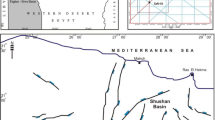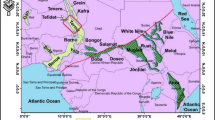Abstract
The present work deals with the evaluation of the available geophysical logs representing the Nubia sandstone reservoir in the Nageh-1 well in the West Hurghada province in the southwestern part of the Gulf of Suez. The qualitative evaluation shows good conditions for oil production in the uppermost zone between depths of 7595 and 7606 ft. The detailed petrophysical parameters necessary to evaluate the reservoir in this zone show a water saturation of 58%, a shale volume of 31%, a total porosity of 17%, an effective porosity of 10%, and a bulk volume of water of 0.06. This evaluation indicates that there are relatively good petrophysical properties for producing oil from the zone of interest. However, the production data revealed that the Nageh-1 well is dry, although it displays oil shows opposite this interval. The present work suggests that the reason responsible for considering the Nageh-1 well to be a dry well is that the hydrocarbon retained in the Nubia sandstone reservoir in this well is residual oil which is not moving through the production process. This finding comes through the calculation of the movable hydrocarbon index (Sw/Sxo = the water saturation in the uninvaded zone divided by the water saturation in the flushed zone), which is always above 1.0 in the examined zone.







Similar content being viewed by others
Data availability
The used data are confidential.
References
Abd-Allah ZM, Abdullah WH, Abdel-Fattah MI (2019) Assessment of Eocene, Paleocene and Cretaceous source rocks in the West Feiran area, offshore Gulf of Suez, Egypt. J Pet Sci Eng 180:756–772
Abd El Gawad E, Abd El Hafez N, Hammed MS, El Naggar HA (2016) Characterization of pre-rift reservoirs of western Hurghada district, Egypt. Int J Innov Sci Eng Technol 3(12):74–83
Alsharhan AS (2003) Petroleum geology and potential hydrocarbon plays in the Gulf of Suez rift basin, Egypt. AAPG Bull 87(1):143–180
Alsharhan AS, Salah MG (1997) Lithostratigraphy, sedimentology and hydrocarbon habitat of the pre-Cenomanian Nubian Sandstone in the Gulf of Suez Oil Province, Egypt. Geo Arabia 2(4):385–400
Archie GE (1942) The electrical resistivity log as an aid in determining some reservoir characteristics. Pet Technol 5:54–62
Asquith GB (1980) Log analysis by microcomputer. PennWell, Tulsa, p 105
Asquith GB (1985) Handbook of log evaluation techniques for carbonate reservoirs. Methods in exploration series, volume 5. AAPG, Tulsa
Asquith G, Gibson C (1982) Basic well log analysis for geologists. Methods in exploration series. AAPG, Tulsa
Attia I, Helal I, El Dakhakhny A, Aly SA (2017) Using sequence stratigraphic approaches in a highly tectonic area: case study—Nubia (A) sandstone in southwestern Gulf of Suez, Egypt. J Afr Earth Sci 136:10–21
Buckles RS (1965) Correlating and averaging connate water saturation data. J Can Pet Technol 4(1):42–52
El Sharawy MS, Gaafar GR (2016) Reservoir zonation based on statistical analyses: a case study of the Nubian sandstone, Gulf of Suez, Egypt. J Afr Earth Sci 124:199–210
El Sharawy MS, Gaafar GR (2019) Impacts of petrophysical properties of sandstone reservoirs on their irreducible water saturation: implication and prediction. J Afr Earth Sc 156:118–132
El Sharawy MS, Nabawy BS (2019) Integration of electrofacies and hydraulic flow units to delineate reservoir quality in uncored reservoirs: a case study, Nubia sandstone reservoir, Gulf of Suez Egypt. Nat Resour Res 28(4):1587–1608
El Diasty WS, El Beialy SY, Mostafa AR, Abo Ghonaim AA, Peters KE (2020) Chemometric differentiation of oil families and their potential source rocks in the Gulf of Suez. Nat Resour Res 29(3):2063–2102
El-Barkooky AN (1992) Stratigraphic framework of the Paleozoic in the Gulf of Suez region, Egypt. In: Proc 1st Conf on Geology of Arab World; 1992 Jan 18–23; Cairo, Eygpt, pp 1–19
El-Gendy N, Barakat M, Abdallah H (2017) Reservoir assessment of the Nubian sandstone reservoir in South Central Gulf of Suez Egypt. J Afr Earth Sci 129:596–609
Elgendy NT, Abuamarah BA, Nabawy BS, Ghrefat H, Kassem OM (2020) Pore fabric anisotropy of the Cambrian–Ordovician Nubia sandstone in the onshore Gulf of Suez, Egypt: a surface outcrop analog. Nat Resour Res 29:1307–1328.
El-Khoriby EM (2003) Sedimentology and diagentic evolution of alluvial plain sandstones: evidence from the Nubia formation (Upper Cretaceous), Eastern desert, Egypt. In: Third Int Conf on the Geology of Africa, Assuit, Egypt, 8–10 Feb 2003, 1:547–570
El-Shayeb H, El-Hemaly IA, Aal EA, Saleh A, Khashaba A, Odah H, Mostafa R (2013) Magnetization of three Nubia Sandstone formations from Central Western Desert of Egypt. NRIAG J Astron Geophys 2(1):77–87
Farouk S, Sen S, Pigott JD, Sarhan MA (2022) Reservoir characterization of the middle Miocene Kareem sandstones, Southern Gulf of Suez Basin Egypt. Geomech Geophys Geo-Energy Geo-Resour 8(5):130
Farouk S, Sen S, Belal N, Omran MA, Assal EM and Sarhan MA (2023) Assessment of the petrophysical properties and hydrocarbon potential of the Lower Miocene Nukhul Formation in the Abu Rudeis-Sidri Field, Gulf of Suez Basin, Egypt. Geomech Geophys Geo-Energy Geo-Resour 9:36
Fertl WH, Vercellino WC (1978) Predict water cut from well logs. In: Practical log analysis, part 4. Oil Gas J 15 May 1978–19 Sept 1979
Hassan AM (2017) Mineral composition and geochemistry of the upper cretaceous siliciclastics (Nubia Group), Aswan district, south Egypt: implications for provenance and weathering. J Afr Earth Sci 135:82–95
Imam TS, Abdel-Fattah MI, Tsuji T, Hamdan HA (2022) Mapping the geological structures in the Ras El Ush field (Gulf of Suez, Egypt), based on seismic interpretation and 3D modeling techniques. J Afr Earth Sc 193:104596
Kassab MA, Hashish MFA, Nabawy BS, Elnaggar OM (2017) Effect of kaolinite as a key factor controlling the petrophysical properties of the Nubia sandstone in central Eastern Desert, Egypt. J Afr Earth Sci 125:103–117
Kassem AA, Hussein WS, Radwan AE, Anani N, Abioui M, Jain S, Shehata AA (2021) Petrographic and diagenetic study of siliciclastic Jurassic sediments from the northeastern margin of Africa: implication for reservoir quality. J Petrol Sci Eng 200:108340. https://doi.org/10.1016/j.petrol.2020.108340
Kassem AA, Osman O, Nabawy B, Baghdady A, Shehata AA (2022) Microfacies analysis and reservoir discrimination of channelized carbonate platform systems: an example from the Turonian Wata Formation, Gulf of Suez. Egypt J Petrol Sci Eng 212:110272. https://doi.org/10.1016/j.petrol.2022.110272
Mostafa R, Khashaba A, El-Hemaly IA, Takla EM, Abdel Aal E, Odah H (2016) 1st paleomagnetic investigation of Nubia Sandstone at Kalabsha, south Western Desert of Egypt. NRIAG J Astron Geophys 5(1):254–262
Nabawy BS, Géraud Y (2016) Impacts of pore- and petrofabrics, mineral composition and diagenetic history on the bulk thermal conductivity of sandstones. J Afr Earth Sci 115:48–62
Nabawy BS, Khalil HM, Fathy MS, Ali F (2020) Impacts of microfacies type on reservoir quality and pore fabric anisotropy of the Nubia sandstone in the central Eastern Desert, Egypt. Geol J 55(6):4507–4524
Peijs JAMM, Bevan TG, Piombino JT (2012) The Gulf of Suez rift basin. In: Roberts B (ed) Phanerozoic rift systems and sedimentary basins. Elsevier, Amsterdam, pp 165–194
Pickett GR (1972) Practical formation evaluation. GR Pickett Inc., Golden
Poupon A, Leveaux J (1971) Evaluation of water saturation in shaly formations. In: 12th SPWLA Annual Logging Symp, Dallas, TX, USA, 2–5 May 1971
Radwan AE, Husinec A, Benjumea B, Kassem AA, Abd El Aal AK, Hakimi MH, Thanh HV, Abdel-Fattah MI, Shehata AA (2022) Diagenetic overprint on porosity and permeability of a combined conventional-unconventional reservoir: insights from the eocene pelagic limestones, Gulf of Suez, Egypt. Mar Pet Geol 146:105967. https://doi.org/10.1016/j.marpetgeo.2022.105967
Said R (1990) The geology of Egypt. AA Balkema, Rotterdam
Salah MG (1994) Geology of the northwestern Red Sea with special emphasis on the petrology, sedimentology and hydrocarbon potential of the Miocene Kareem Formation. Ph.D. thesis. Cairo University, Cairo, pp 1–166
Sarhan MA (2020) Geophysical appraisal and oil potential for Rudeis formation at West Hurghada area, southern Gulf of Suez: detection of stratigraphic trap. Arab J Geosci 13(6):1–9
Sarhan MA (2021a) Petrophysical characterization for Thebes and Mutulla reservoirs in Rabeh East Field, Gulf of Suez Basin, via well logging interpretation. J Pet Explor Prod Technol. https://doi.org/10.1007/s13202-021-01288-x
Sarhan MA (2021b) Geophysical and hydrocarbon prospect evaluation of Nukhul formation at Rabeh East oil field, Southern Gulf of Suez Basin, Egypt. J Pet Explor Prod Technol 11(7):2877–2890
Sarhan MA, Basal AMK (2019) Evaluation of Nubia sandstone reservoir as inferred from well logging data interpretation for Rabeh East-25 well, Southwest Gulf of Suez, Egypt. J Afr Earth Sci 155:124–136
Schlumberger (1972a) Log interpretation manual/principles, vol. I. Schlumberger Well Services, Inc., Houston
Schlumberger (1972b) Log interpretation/charts. Schlumberger Well Services, Inc., Houston
Schlumberger (1984) Well evaluation conference, Egypt. Schlumberger, Cairo, p 250
Shazly TF, Tarabees E (2013) Using of dual laterolog to detect fracture parameters for Nubia sandstone formation in Rudeis-Sidr area, Gulf of Suez, Egypt. Egypt J Pet 22(2):313–319
Shehata AA, Kassem AA, Brooks HL, Zuchuat V, Radwan AE (2021) Facies analysis and sequence-stratigraphic control on reservoir architecture: example from mixed carbonate/siliciclastic sediments of Raha Formation, Gulf of Suez, Egypt. Mar Pet Geol 131:105160. https://doi.org/10.1016/j.marpetgeo.2021.105160
Shehata AA, Tahoun SS, Kassem AA, Abdelsamea EG, Hassan HF (2023) Palynostratigraphy and paleoenvironmental inferences of the Jurassic successions, Darag Basin, Gulf of Suez, Egypt. J Afr Earth Sci 200:104890. https://doi.org/10.1016/j.jafrearsci.2023.104890
Thorseth J (2003) Saqqara oil field. GUPCO internal report. GUPCO, Cairo, p 52
Acknowledgements
The authors are grateful to the Egyptian General Petroleum Corporation (EGPC) and the Ganoub El-Wadi Petroleum Holding Company for providing the data presented in this article.
Funding
There is no particular funding for the present study.
Author information
Authors and Affiliations
Corresponding author
Ethics declarations
Conflict of interest
Here we confirm that there is no conflict of interest for the existing study.
Ethical approval
We declare that this paper reflects our own research and analysis and it has not been published before.
Additional information
Responsible Editor: Mohamed Ksibi.
Rights and permissions
Springer Nature or its licensor (e.g. a society or other partner) holds exclusive rights to this article under a publishing agreement with the author(s) or other rightsholder(s); author self-archiving of the accepted manuscript version of this article is solely governed by the terms of such publishing agreement and applicable law.
About this article
Cite this article
Sarhan, M.A., Basal, A.M.K. Movable hydrocarbon index as a tool for evaluating reservoir quality: a case study of the Nubia sandstone in West Hurghada province (southern Gulf of Suez, Egypt). Euro-Mediterr J Environ Integr 8, 613–623 (2023). https://doi.org/10.1007/s41207-023-00381-3
Received:
Accepted:
Published:
Issue Date:
DOI: https://doi.org/10.1007/s41207-023-00381-3




